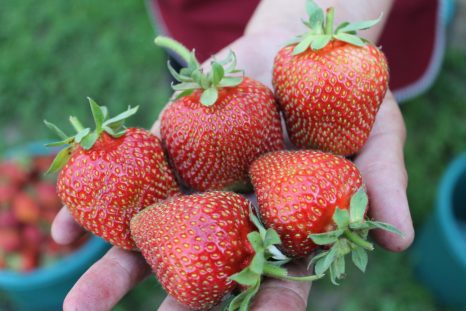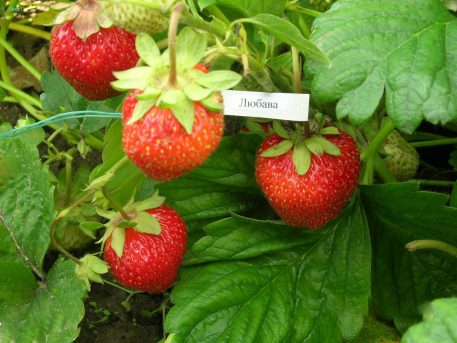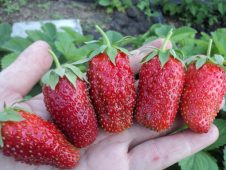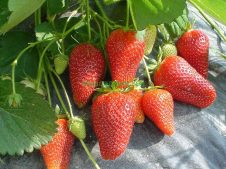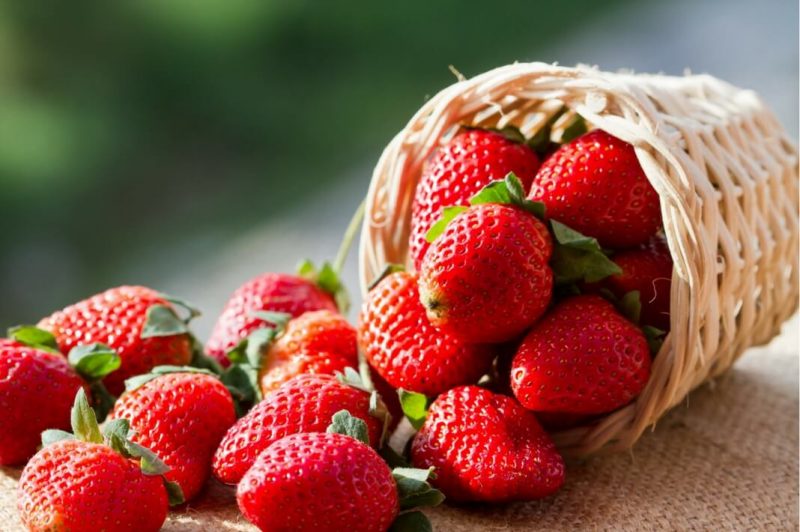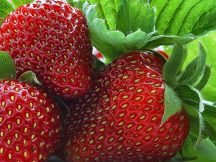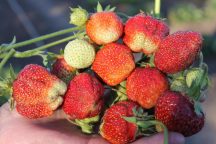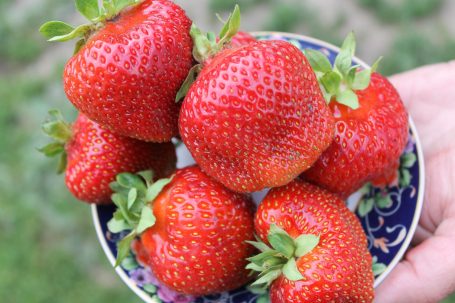Strawberries are a favorite berry. The appearance of her first berries in the garden is always looking forward to. If there is strawberry on the table, then summer has come. However, in order to get a crop of this sweet and tender berry, you need to choose the right strawberry variety.
Material Content:
What types of strawberries exist
Types and varieties of strawberries can differ from each other according to different criteria. This is a cultivation technique, disease resistance, ripening time, yield, appearance, taste and so on.

The most important criterion is the fruiting time. Most varieties yield once a year. Among them are those that mature early, they are called“Early”. Then - ready for harvest in mid-summer, so they are called Mid-season. And finally, those whose bushes can be removed even in late autumn. Accordingly, they are called “Late”. In addition to varieties bearing fruit once a year, there are also “long-playing” ones. They can produce crops up to three times a year and are called remontant.
Varieties are also classified by the size of berries, distinguishing among all varieties decorative. They have large fruits, which sometimes reach over 100 g by weight.
Distinguish by color red and white strawberries. The latter has an exotic appearance. It can be berries of a beige hue, a little darker or lighter, with bright red or yellow seeds. Varieties also vary in taste. For example, with a touch of pineapple, cherry, honey.
Which is better, domestic or foreign varieties
There are many wonderful domestic varieties of strawberries.Many of them were bred back in Soviet times and are very popular even after decades. However, I would like to try foreign varieties to fully appreciate their merits, appearance, unusual aroma and taste.
It should be borne in mind that West European strawberry varieties do not tolerate Russian winters and frosts. While domestic ones can withstand very severe winters and are designed for temperatures of –10 ° С without snow cover. American varieties are often not adapted for sharply continental climate. Therefore, here you need to be very careful about certain characteristics of foreign culture when choosing. First of all, considering in which climatic zone you can grow it.
The yield of foreign varieties on Russian lands is quite commensurate with domestic ones. But to taste European strawberries are more sweet.
Strawberry Repairing Varieties
Repairing varieties have a remarkable feature - the crop can be harvested three times during the summer. Usually the first berries are picked in July, then the next "wave" ripens in August. The third time they harvest strawberries in September-October, if they did not have time to burst frost.
The largest crop, as a rule, happens the second time. Its volume can well be regulated with the help of agricultural technologies. Small-fruited varieties yield more and more often, and large-fruited ones less and less, respectively.
The following varietal strawberries are noteworthy:
- Temptation. A hybrid variety that looks so wonderful that it is used even in decorative gardening to decorate the site. It has fairly large fruits (up to 30 g) with a nutmeg flavor.
- Moscow delicacy. It tolerates frosts, has a strong immunity to various diseases. The berries are large (up to 35 g) with a pleasant cherry flavor.
- Dynamite. An American variety that copes with diseases and pests. It has a light flesh and a very pleasant, delicate taste.
- Albion. Wonderful variety - bright, sweet, fragrant. It tolerates all weather anomalies.
Dessert (large) types of culture
Big bright berries always attract attention. Gardeners always want to grow beautiful large strawberries on their plot. Dessert varieties are also distinguished by this feature. At the same time, they have additional advantages - wonderful taste and wonderful aroma.
- Gigantella. There are a lot of fans of this variety in the territory of the former USSR, since its berries differ in really gigantic sizes - up to 125 g. Ripens in June, up to 3 kg of fruits can be removed from the bush. Transportation over long distances is not at all afraid.
- Ducat. It tolerates frosts. The berries are large up to 40 g, the pulp is pleasant, elastic. The peculiarity of the variety is that it is excellent in processing. It turns out wonderful jam, compotes, because the aroma of fresh strawberries is preserved. Suitable for transportation.
- Cleary. Italian variety - that’s it. It is better to grow it in the south, and in the middle lane there is a need to cover with a film. The Clery variety has a simply amazing taste: absolute sweetness, and sourness is not even felt. Very resistant to diseases - to fungal infections.
- Kent. Gardeners appreciated this variety, since for more than 30 years it has been very popular. The fruits are very large and, perhaps, second only to the Gigantella. Its unpretentiousness in leaving and good immunity attracts. It has a very pleasant taste.
Early strawberries
Flowering early strawberries begins in May, after the 15th day. Fruits begin to receive in mid-June. You need to know that early strawberry yields are always significantly inferior to those with later ripening. Sometimes this difference is almost 50%. The following early strawberry varieties are popular:
- Mommy. This variety is popular with gardeners because it is quite resistant to a variety of diseases - from powdery mildew to verticillosis. He tolerates winter perfectly. It can be grown in almost any climate zone. The sweet taste of these bright red berries is liked by many strawberry lovers. Fruits are usually medium in size. Sometimes quite large specimens come across - up to 30 g.
- Alice. The variety is intended for the southern regions of Crimea, the North Caucasus, since it does not differ in winter hardiness. Immunity is average, therefore, needs good care. Wonderful sweet taste with delicate sourness. The fruits are dark, saturated red.
- Alba. A variety of Italian breeding, which is not afraid of early frosts and Russian winters. It has excellent resistance to various diseases. It gives a pretty decent crop. Berries are large up to 30 g of bright red color. Perfectly suited for transportation and even mechanized collection.
- Viola. Russian breeders bred a specially winter-hardy variety that is well suited to the Volga-Vyatka region. Remarkably resists drought, strawberry tick. However, under favorable conditions for diseases - excessive humidity, it easily gets sick with gray rot. This strawberry is completely unsuitable for transportation or canning. Bright red berries are preferably eaten fresh directly from the garden. Its features are sweet taste, plenty of juice.
- Kokinskaya dawn. Suitable for the south of Russia and the Black Earth region. Its advantage is a wonderful immunity to various diseases. It gives a wonderful harvest. It tastes sweet and sour, tender. It tolerates winter as well as hot, dry summers. If humidity is too high, gray rot may appear. It’s absolutely not suitable for transportation.
- Asia. It withstands winter and frost. It tolerates drought and heat. Strawberry Asia has good resistance to root diseases. She has a wonderful bright sweet taste with a slight sourness. Berries are scarlet, large enough - up to 90 g.
Mid-ripe varieties of berries
Flowering mid-season strawberry varieties begin in late May. The first fruits appear in mid-summer.
- Masha. This wonderful variety was created by Soviet scientists. He is still loved. Gardeners appreciate him for tolerating winter and frost easily. Amazing berries are very large, can weigh more than 100 g. The shape of such berries is unusual - fan-shaped, as if gathered by folds. These huge berries have an interesting feature to grow together. Their color is dark, the taste is sweet. The juicy pulp of the fruit is elastic; inside it has no empty cavities. Productivity is not as high as we would like, because a plant with large berries does not produce too many fruits. She is not afraid of diseases of the root system, but dampness can provoke the appearance of gray rot in the folds of the fruit.
- Wondrous. The variety is still Soviet selection of very high quality. Designed for landing in the middle lane. It is not suitable for southern areas, because it does not tolerate heat well. In general, it resists various diseases very well. His only enemy is gray rot, although even here the variety demonstrates quite tolerable stability. Berries are about 25 g in size. Their taste is sweet and sour, tart. The color of the fruit is light. The pulp is dense, with a wonderful aroma. The fruit contains a lot of vitamin C.
- Borovitskaya. Domestic variety intended for the Central Black Soil and Volga-Vyatka regions. Suitable also for the Primorsky Territory. It tolerates both drought and frost. Immunity is very high. The only drawback is the difference in the size of the fruits that appear during fruiting. However, the taste is beautiful: different pleasant sour notes. The color is light, the aroma is wonderful, the pulp is quite dense. For transportation over short distances, it fits very well.
- Slavutich. Suitable for the Middle Volga and Central regions.The berries are small, with a high content of vitamin C, so the sour taste prevails. The main advantage is excellent immunity. The variety is not afraid of either rot, or ticks, or nematodes. It tolerates winter and frost.
- Queen. The most important advantage is that the variety tolerates both heat with drought and harsh winter. In the absence of snow cover, it can withstand severely low temperatures up to -15 ° C. The berries are slightly larger than the average size, reach 30 g. The taste is magnificent, sweet, the color is bright red. Suitable for transportation over long distances.
Late species
Later varieties of strawberries begin to bloom in late June, and bear fruit until October.
- Bereginya. This is a tenacious variety that tolerates winter, heat and drought. Various diseases and pests are practically not terrible for him. The berries are quite large, up to 25 g, and contain a large amount of vitamin C. The fruits are light with an orange tint, a noticeable brilliance. Therefore, at first glance it seems unripe, but their flesh is bright, red. The aroma is very pleasant, and the taste is sweet and sour.
- Alpha. It is considered the best Russian variety, as it has good immunity to the vast majority of problems. It tolerates adverse weather conditions. Berries are usually medium in size, red in color - good, juicy, fragrant. The taste is pleasant acidity. They are good in transportation and are great for homemade products - jams, jams, compotes.
- Izaura. This unpretentious variety was created in Belgium. Perfectly adapted for clay soils, tolerates drought, frost well. However, it is hardly suitable for regions with harsh winters. Remarkably resists main diseases. It can be used for long transportation. Harvest usually get high. The berries are bright, the skin is shiny, red. The taste is very pleasant with a slightly noticeable acidity.
- Bounty. Bred in Canada, does not require serious care. It is immune to gray rot, but powdery mildew is very seriously ill. The berries are dark in color and weigh up to 30 g. A distinctive feature is a strong aroma. The taste is sweet and sour, saturated.
- Carmen. Another foreign variety comes from Czechoslovakia. Unfortunately, it does not tolerate winter and drought. But the berries are of remarkable quality, weigh almost 40 g. Fine dark color. The taste is sweet with a slightly sour note. Productivity is average, but stable.
The best varieties for growing seedlings
To choose the best varieties of strawberries for seedlings, you must learn certain rules. The main part of the plantings, more than half, should consist of proven, reliable and familiar varieties. You can add to them something unusual, exotic in appearance, taste or for some special properties. So you can try new unusual varieties, while the yield as a whole will not be affected.
It is best to choose those plants that are approved by specialists and are included in the official document - the State Register of Selection Achievements. These varieties are perfect for growing both in Russia and in the CIS countries. They have already proven themselves well, and you can always find reliable information on caring for them.
When choosing, consider the following:
- Climatic conditions.
- Type of soil - strawberries as a whole perfectly bear fruit in different soils, but there are some varieties that may require a certain type of land.
- Resistance to diseases - in certain places corresponding infections are common.
- Decide where and how strawberries will grow on your site - there are horizontally and vertically growing varieties.
- Taste, aroma, color, fruit shape.
According to statistics, most often gardeners prefer these varieties:
- Victoria;
- Gigantella
- Gum;
- Masha;
- Camarose;
- Anapolis
- Fragora
- Regina.
Since it is these varieties that differ in all the qualities necessary for an ordinary garden plot.
Views suitable for the greenhouse
Strawberry varieties for the greenhouse should be selected for which it will be easy to care for. Therefore, they must have high immunity, good productivity in order to perfectly bear fruit in the winter. With the help of breeding, the following remarkable varieties were developed that have all these qualities inherent.
- Marshal. Tasty, juicy, sweet berries of bright red color. It is a repairing variety suitable for growing in greenhouses. It has large, richly green leaves that give an extensive shadow. As a result, weeds do not have enough light, and they simply do not grow on the beds. Therefore, the marshal needs minimal care. In addition, it tolerates the adverse conditions of drought very well: it does not need regular watering.
- Honey. Specially bred for greenhouse conditions. This repairman perfectly adapts to adverse climatic conditions, is not afraid of frosts. It has excellent resistance to most diseases of strawberries. The berry is large, up to 45 g, beautiful in shape and dark red in color with a glossy surface. Berries perfectly tolerate transportation.
- Elizabeth the Second. It is distinguished by unusually large berries of a sweet taste. A repairing variety, so it does not need to be planted every year. Fruits appear both on last year's bushes and on young ones. They need to be collected only after full maturity. It is quite transportable, so it can be grown for sale.


